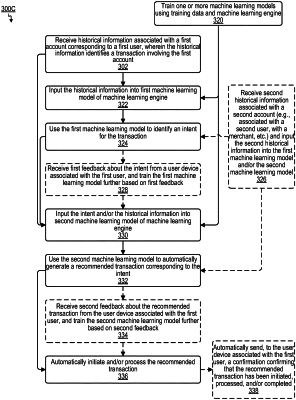| CPC G06Q 20/22 (2013.01) [G06N 20/00 (2019.01)] | 87 Claims |

|
1. A method of automated payment account interaction using a server, the method comprising:
training a first neural network using a first training dataset associated with an account corresponding to a first user;
training a second neural network using a second training dataset associated with the account corresponding to the first user;
dynamically receiving historical information associated with the account corresponding to the first user;
processing the historical information using a first neural network to identify an intent, wherein a first set of weights and a first set of connections of the first neural network contribute to the identification of the intent, wherein the intent continues to be updated in real-time as the historical information continues to be received, and wherein the intent relates to an asset associated with the first user;
selecting a recommended second user for a communication with the first user based on the intent and an association between the recommended second user and the asset, wherein selecting includes processing the intent using a second neural network, wherein a second set of weights and a second set of connections of the second neural network contribute to the selection of the recommended second user;
initiating a communication between the first user and the recommended second user, wherein the communication is related to the asset, and wherein the communication includes feedback; and
retraining the first neural network using the feedback in real-time as the feedback is extracted from the communication, wherein retraining uses the feedback to modify the first set of weights to improve accuracy of the first neural network at identifying one or more additional intents, and wherein the modification strengthens or weakens the first set of weights based on whether the feedback is positive or negative.
|